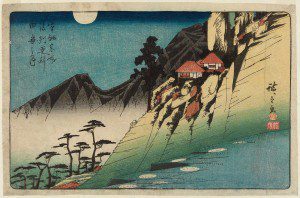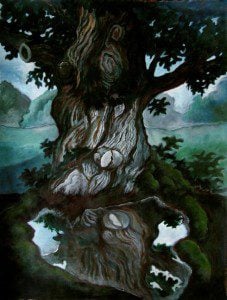
From a thousand years ago, in a slim autobiographical novel gusting with moonlight and desire, we have a dozen dreams of an anonymous Japanese woman who was born in Kyoto in 1008. The book itself is untitled; sometimes it is called the Sarashina Nikki (literally, “The Day-Record of Sarashina”). The translator of the Penguin edition, Ivan Morris, decided to import a title from an even older work, a poem titled, “As I Crossed a Bridge of Dreams.”
The author, whose name is unknown, belonged to a remarkable group of Japanese women writers of the tenth and eleventh centuries. We know almost nothing of their lives, not even their names. A modern editor suggests that their extraordinary accomplishments “produced an unconscious resentment among male scholars, with the result that these talented ladies were permanently condemned to anonymity.” One of them was this author’s aunt, who wrote a searing tale of jealousy, Kagero Nikki (“Gossamer Years”).
By convention, the anonymous author of Bridge of Dreams is called Lady Sarashina, a name borrowed from a mountainous area she probably never visited. The daughter of a minor provincial governor who resented being posted outside the capital, she led a secluded life, mostly behind garden walls inKyoto, until she became a lady-in-waiting to a princess at thirty-one. Her court connection may have helped her to marry at thirty-six, very late in her day; she had children. Her prose style was lovely; the poems that punctuate her recollections (an epistolary mode of the time) are mostly forgettable.
She told no one her dreams, and failed to take actions suggested by the early dreams in the series. She later regrets failing to act on her dreams, realizing that they could have steered her life on a better course.
She loved stories and romances, and the first dreams she records – one features a “handsome priest” – came in the midst of her binge reading of women’s writing like the Tales of Genji. Some dreams were experienced at temples, to which she journeyed on pilgrimages that were sometimes cherry-blossom tours, sometimes belated efforts to honor dream directions. Japanese classical scholar Ikeda Kikan says: “The author of Sarashina Nikki can be regarded as the first person in Japanese literature to have discovered dreams…Her dreams are not fortuitous interludes but are consciously grasped as having a definite, inevitable meaning.” This is the first Japanese book in which dreams play a central role. Life itself has the quality of dream, a flimsy bridge between different shores.
Her book resembles the modern Japanese genre known as the sh-shosetsu, the “I-novel”, in which the author weaves facts of his life together with imagination.

